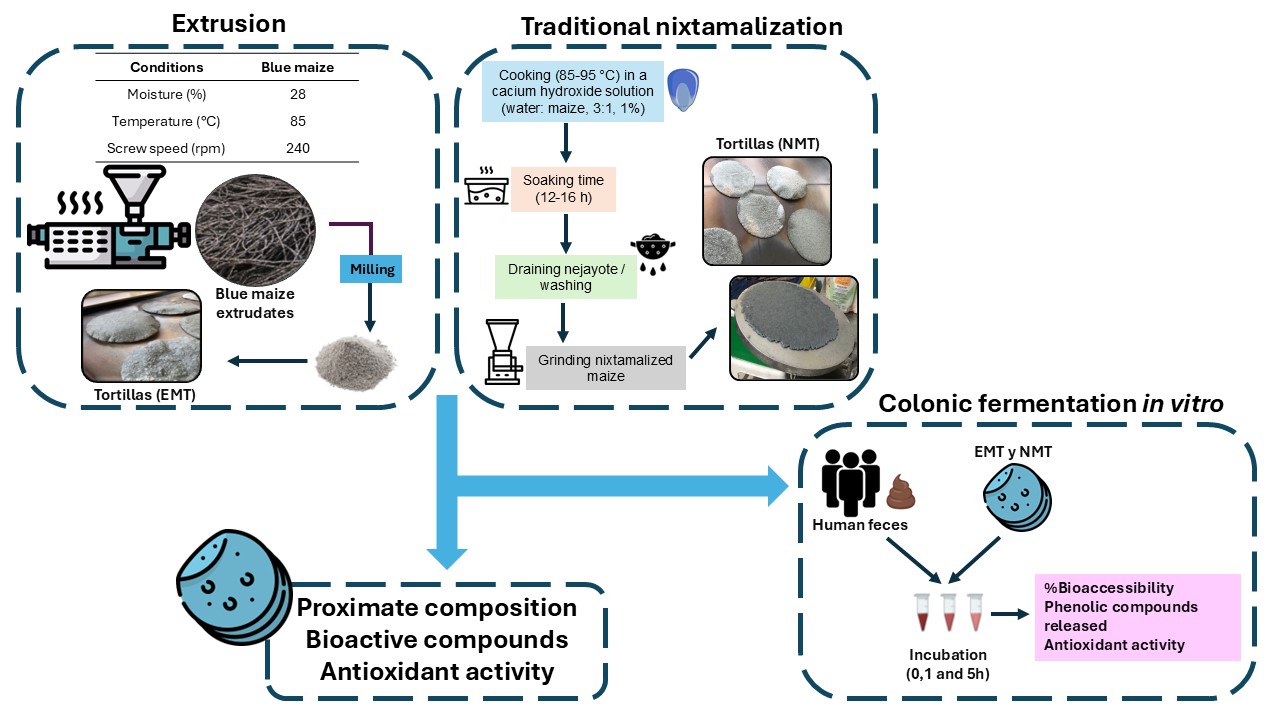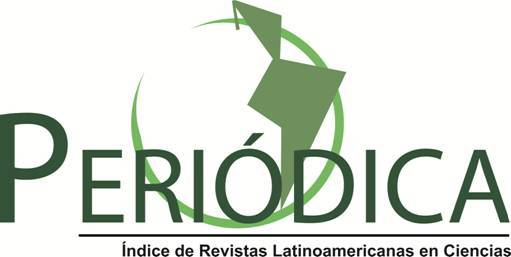Efecto del Proceso de Nixtamalización Tradicional y Extrusión sobre la Bioaccesibilidad y Actividad Antioxidante de Compuestos Fenólicos de Tortillas de Maíz Azul Durante la Fermentación In Vitro por la Microbiota Colónica Humana
DOI:
https://doi.org/10.18633/biotecnia.v27.2520Palabras clave:
Tortillas, fenólicos, bioaccesibilidad, antioxidantes, maíz azulResumen
En los últimos años las tortillas elaboradas con maíces pigmentados han despertado interés debido al aporte de polifenoles, los cuales son considerados antioxidantes naturales y poseen propiedades antihipertensivas, antidiabéticas, y anticarcinogénicas. En maíz, el mayor aporte de polifenoles se encuentra en forma insoluble. Estos metabolitos secundarios son liberados por la microbiota del colón haciéndolos más bioaccesibles para el organismo. En el presente trabajo se evaluó y comparó bioaccesibilidad, liberación de compuestos fenólicos y actividad antioxidante por la microbiota colónica en tortillas elaboradas con maíz azul nixtamalizado (NMT) y extrudido (EMT). Las EMT presentaron mayor contenido de proteína, lípidos y cenizas, con respecto NMT. Sin embargo, NMT presentó mayor contenido de antocianinas que su contraparte EMT (4.01 y 2.28 mg ECG/100 g, bs). La fracción de fenólicos ligados en ambas tortillas representa > 80 %. A las 5 h de fermentación in vitro por la microbiota del colon, NMT mostró el mayor promedio de liberación y bioaccesibilidad de fenólicos, y actividad antioxidante [11.78 mg EAG/g, bs, 88.23 %, y 569.82 (ORAC) y 26.76 (ABTS) µmol ET/g] que EMT. El proceso de nixtamalización tradicional para elaborar tortillas seguirá siendo clave importante para el aporte de beneficios en la salud de los consumidores.
Descargas
Citas
Aguayo-Rojas, J., Mora-Rochín, S., Cuevas-Rodríguez, E.O., Serna-Saldívar, S.O., Gutiérrez-Uribe, J.A., Reyes-Moreno, C. and Milán-Carrillo, J. 2012. Phytochemicals and antioxidant capacity of tortillas obtained after lime-cooking extrusion process of whole pigmented Mexican maize. Plant Foods for Human Nutrition. 67:178-185.
Association of Official Analytical Chemist (AOAC). 2005. Official Methods of Analysis. 18th ed. Washington: AOAC
Astorga-Gaxiola, A.H., Reyes-Moreno, C., Milán-Carrillo, J., Jiménez-Edeza, M., Cuevas-Rodríguez, E.O., Castañeda-Ruelas, G.M. and Mora-Rochín, S. 2023. Release of phenolic compounds with antioxidant activity by human colonic microbiota after in vitro fermentation of traditional white and blue maize tortillas. International Food Research Journal. 30(1): 240-251.
Baky, M.H., Salah, M., Ezzelarab, N., Shao, P., Elshahed, M.S. and Farag, M.A. 2022. Insoluble dietary fibers: structure, metabolism, interactions with human microbiome, and role in gut homeostasis. Critical Reviews in Food Science and Nutrition. 64(7): 1954–1968.
Bello-Pérez, L.A., Flores-Silva, P.C., Camelo-Méndez, G.A., Paredes-López, O. and Figueroa-Cárdenas, J.D. 2015. Effect of the Nixtamalization Process on the Dietary Fiber Content, Starch Digestibility, and Antioxidant Capacity of Blue Maize Tortilla. Cereal Chemistry Journal. 92(3): 265–270.
Blancas-Benítez, F.J., Pérez-Jiménez, J., Montalvo-González, E., González-Aguilar, G.A. and Sáyago-Ayerdi, S.G. 2018. In vitro evaluation of the kinetics of the release of phenolic compounds from guava (Psidium guajava L.) fruit. Journal of Functional Foods. 43: 139-145.
Bonilla-Vega, L., Hernandez-Castro, E., Gutierrez-Dorado, R., Villamar-Vázquez, M., Sarabia-Ruiz, G. and Valenzuela Lagarda, J.L. 2022. Effect of nixtamalization extrusion conditions in purple creole corn (Zea mays L.) from the state of Guerrero on nutraceutical and functional properties of the optimized corn flour. Food Science and Technology. 42: e108122.
Butts-Wilmsmeyer, C.J., Mumm, R.H., Rausch, K.D., Kandhola, G., Yana, N.A., Happ, M.M., Ostezan, A., Wasmund, M. and Bohn, M.O. 2018. Changes in Phenolic Acid Content in Maize during Food Product Processing. Journal of Agricultural and Food Chemistry. 66(13): 3378–3385.
Calvo-Lerma, J., Paz-Yepez, C., Asensio-Grau, A., Heredia, A. and Andres, A. 2020. Impact of processing and intestinal conditions on in vitro digestion of chia (Salvia hispanica) seeds and derivatives. Foods. 9(3): 290.
Campos‐Vega, R., Reynoso‐Camacho, R., Pedraza‐Aboytes, G., Acosta‐Gallegos, J.A., Guzman‐Maldonado, S.H., Paredes‐Lopez, O., Oomah, B.D. and Loarca‐Piña, G. 2009. Chemical composition and in vitro polysaccharide fermentation of different beans (Phaseolus vulgaris L.). Journal of Food Science. 74(7): T59-T65.
Cervantes-Ramírez, J.E., Cabrera-Ramirez, A.H., Morales-Sánchez, E., Rodriguez-García, M.E., de la Luz Reyes-Vega, M., Ramírez-Jiménez, A.K., Contreras-Jiménez, B.L. and Gaytán-Martínez, M. 2020. Amylose-lipid complex formation from extruded maize starch mixed with fatty acids. Carbohydrate Polymers. 246: 116555.
Chen, J., Shu, Y., Chen, Y., Ge, Z., Zhang, C., Cao, J., Li, X., Wang, Y. and Sun, C. 2022. Evaluation of antioxidant capacity and gut microbiota modulatory effects of different kinds of berries. Antioxidants. 11(5): 1020.
Choton, S., Gupta, N., Bandral, J.D., Anjum, N. and Choudary, A. 2020. Extrusion technology and its application in food processing: A review. The Pharma Innovation Journal. 9(2): 162-168.
Colín-Chávez, C., Virgen-Ortiz, J.J., Serrano-Rubio, L.E., Martinez-Tellez, M.A. and Astier, M. 2020. Comparison of nutritional properties and bioactive compounds between industrial and artisan fresh tortillas from maize landraces. Current Research in Food Science. 3: 189-194.
Domínguez-Ávila, J.A., Villa-Rodriguez, J.A., Montiel-Herrera, M., Pacheco-Ordaz, R., Roopchand, D.E., Venema, K. and González-Aguilar, G.A. 2021. Phenolic compounds promote diversity of gut microbiota and maintain colonic health. Digestive Diseases and Sciences. 66(10): 3270-3289.
Domínguez-Hernández, E., Marcela, Gaytán-Martínez, M., Gutiérrez-Uribe, J.A. and Domínguez-Hernández, M.E. 2022. The nutraceutical value of maize (Zea mays L.) landraces and the determinants of its variability: A review. Journal of Cereal Science. 103: 103399.
Enríquez-Castro, C.M., Torres-Chávez, P.I., Ramírez-Wong, B., Quintero-Ramos, A., Ledesma-Osuna, A.I., López-Cervantes, J. and Gerardo-Rodríguez, J.E. 2020. Physicochemical, rheological, and morphological characteristics of products from traditional and extrusion nixtamalization processes and their relation to starch. International Journal of Food Science. 2: 1-12.
Escalante-Aburto, A., Mariscal-Moreno, R. M., Santiago-Ramos, D. and Ponce-García, N. 2020. An update of different nixtamalization technologies, and its effects on chemical composition and nutritional value of corn tortillas. Food Reviews International. 36(5): 456-498.
Gámez-Valdez, L.C., Gutiérrez-Dorado, R., Gómez-Aldapa, C.A., Perales-Sánchez, J.X.K., Milán-Carrillo, J. Cuevas-Rodríguez, E.O., Mora-Rochin, S. and Reyes-Moreno, C. 2021. Effect of the extruded amaranth flour addition on the nutritional, nutraceutical and sensory quality of tortillas produced from extruded creole blue maize flour. Biotecnia. 23(2): 103-112.
Gaxiola-Cuevas, N., Mora-Rochín, S., Cuevas-Rodriguez, E.O., León-López, L., Reyes-Moreno, C., Montoya-Rodríguez, A. and Milán-Carrillo, J. 2017. Phenolic acids profiles and cellular antioxidant activity in tortillas produced from Mexican maize landrace processed by nixtamalization and lime extrusion cooking. Plant Foods for Human Nutrition. 72: 314-320.
Hassan, S.M., Forsido, S.F., Tola, Y.B., Bikila, A.M. and Ahmed, Z. 2023. Effect of nixtamalization on the nutritional, anti-nutritional, functional, physicochemical and mineral properties of maize (Zea mays) tortillas. Journal of Food Chemistry and Nanotechnology. 9(3): 132-140.
Hou, Q., Zhao, F., Liu, W., Lv, R., Khine, W. W. T., Han, J., Sun, Z., Lee, Y.K. and Zhang, H. 2020. Probiotic-directed modulation of gut microbiota is basal microbiome dependent. Gut Microbes. 12(1): 1736974.
Inada, K.O.P., Silva, T.B.R., Lobo, L.A., Domingues, R.M.C. P., Perrone, D. and Monteiro, M. 2020. Bioaccessibility of phenolic compounds of jaboticaba (Plinia jaboticaba) peel and seed after simulated gastrointestinal digestion and gut microbiota fermentation. Journal of Functional Foods. 67: 103851.
Isenring, J., Bircher, L., Geirnaert, A. and Lacroix, C. 2023. In vitro human gut microbiota fermentation models: opportunities, challenges, and pitfalls. Microbiome Research Reports. 2: 1-15.
Juániz, I., Ludwig, I.A., Bresciani, L., Dall’Asta, M., Mena, P., Del Rio, D., Cid, C. and Peña, M.P. 2017. Bioaccessibility of (poly)phenolic compounds of raw and cooked cardoon (Cynara cardunculus L.) after simulated gastrointestinal digestion and fermentation by human colonic microbiota. Journal of Functional Foods. 32: 195–207.
Kamau, E.H., Nkhata, S.G. and Ayua, E.O. 2020. Extrusion and nixtamalization conditions influence the magnitude of change in the nutrients and bioactive components of cereals and legumes. Food Science & Nutrition. 8(4): 1753-1765.
Martini, S., Conte, A., Cattivelli, A. and Tagliazucchi, D. 2021. Domestic cooking methods affect the stability and bioaccessibility of dark purple eggplant (Solanum melongena) phenolic compounds. Food Chemistry. 341: 128298.
Menchaca-Armenta, M., Frutos, M.J., Ramírez-Wong, B., Valero-Cases, E., Muelas-Domingo, R., Quintero-Ramos, A., Torres-Chávez, P.I., Carbonell-Barrachina, A.A., Ledesma-Osuna, A.I. and Campas-Baypoli, O.N. 2023. Changes in phytochemical content, bioaccesibility and antioxidant capacity of corn tortillas during simulated in vitro gastrointestinal digestion. Food Chemistry. 405: 134223.
Méndez-Lagunas, L.L., Cruz-Gracida, M., Barriada-Bernal, L.G. and Rodríguez-Méndez, L.I. 2020. Profile of phenolic acids, antioxidant activity and total phenolic compounds during blue corn tortilla processing and its bioaccessibility. Journal of Food Science and Technology. 57: 4688-4696.
Milán‐Carrillo, J., Gutiérrez‐Dorado, R., Perales‐Sánchez, J.X.K., Cuevas‐Rodríguez, E.O., Ramírez‐Wong, B. and Reyes‐Moreno, C. 2006. The optimization of the extrusion process when using maize flour with a modified amino acid profile for making tortillas. International Journal of Food Science & Technology. 41(7): 727-736.
Mora-Rochin, S., Milán-Noris, A.K. and Milán-Carrillo, J. 2019. Maize. In: Whole grains, processing, product development, and nutritional aspects. S.A. Mir, A. Manickavasagan, and M.A. Shah (ed), pp 87-102. CRC Press. Boca Raton Florida.
Mora-Rochín, S., Gaxiola-Cuevas, N., Gutiérrez-Uribe, J.A., Milán-Carrillo, J., Milán-Noris, E.M., Reyes-Moreno, C., Serna-Saldívar, S.O. and Cuevas-Rodríguez, E.O. 2016. Effect of traditional nixtamalization on anthocyanin content and profile in Mexican blue maize (Zea mays L.) landraces. LWT-Food Science and Technology. 68: 563-569.
Mora-Rochin, S., Gutiérrez-Uribe, J.A., Serna-Saldivar, S.O., Sánchez-Peña, P., Reyes-Moreno, C. and Milán-Carrillo, J. 2010. Phenolic content and antioxidant activity of tortillas produced from pigmented maize processed by conventional nixtamalization or extrusion cooking. Journal of Cereal Science. 52(3): 502-508.
Pérez-Burillo, S., Molino, S., Navajas-Porras, B., Valverde-Moya, A.J., Hinojosa-Nogueira, D., López-Maldonado, A., Pastoriza, S. and Rufián-Henares, J.A. 2021. An in vitro batch fermentation protocol for studying the contribution of food to gut microbiota composition and functionality. Nature Protocols. 16(7): 3186-3209.
Polia, F., Pastor-Belda, M., Martínez-Blázquez, A., Horcajada, M.N., Tomás-Barberán, F.A. and García-Villalba, R. 2022. Technological and biotechnological processes to enhance the bioavailability of dietary (poly) phenols in humans. Journal of Agricultural and Food Chemistry. 70(7): 2092-2107.
Re, R., Pellegrini, N., Proteggente, A., Pannala, A., Yang, M. and Rice-Evans, C. 1999. Antioxidant activity applying an improved ABTS radical cation decolorization assay. Free Radical Biology and Medicine. 26(9-10): 1231-1237.
Ribas-Agustí, A., Martín-Belloso, O., Soliva-Fortuny, R. and Elez-Martínez, P. 2018. Food processing strategies to enhance phenolic compounds bioaccessibility and bioavailability in plant-based foods. Critical Reviews in Food Science and Nutrition. 58: 2531−2548.
Rocchetti, G., Gregorio, R.P., Lorenzo, J.M., Barba, F.J., Oliveira, P.G., Prieto, M.A., Simal-Gandara, J., Mosele, J.I., Motilva, M.J., Tomas, M., Patrone, V., Capanoglu, E. and Lucini, L. 2022. Functional implications of bound phenolic compounds and phenolics–food interaction: A review. Comprehensive Reviews in Food Science and Food Safety. 21(2): 811-842.
Salinas Moreno, Y., Hernández Martínez, V., Trejo Téllez, L.I., Ramírez Díaz, J.L. and Iñiguez Gómez, O. 2017. Nutritional composition and bioactive compounds in tortillas of native populations of corn with blue/purple grain. Revista Mexicana de Ciencias Agrícolas. 8(7): 1483-1496.
Sánchez-Nuño, Y.A., Zermeno-Ruiz, M., Vázquez-Paulino, O.D., Nuno, K., Villarruel-López, A. 2024. Bioactive compounds from pigmented corn (Zea mays L.) and their effect on health. Biomolecules. 14: 338.
Šárka, E., Sluková, M. and Henke, S. 2021. Changes in phenolics during cooking extrusion: A review. Foods. 10(9): 2100.
Singleton, V., Orthofer, R. and Lamuela, R. 1999. Analysis of total phenols and other oxidation substrates and antioxidant by means of Folin-Ciocalteu reagent. Methods in Enzimology. 299: 152-178.
Tomás-Barberán, F.A. and Espín, J.C. 2019. Effect of food structure and processing on (Poly) phenol–gut microbiota interactions and the effects on human health. Annual Review of Food Science and Technology. 10(1): 221-238.
Ying, W., Shi, Z., Yang, H., Xu, G., Zheng, Z. and Yang, J. 2018. Effect of alkaline lignin modification on cellulase–lignin interactions and enzymatic saccharification yield. Biotechnology for Biofuels. 11: 214-227.

Publicado
Cómo citar
Número
Sección
Licencia
Derechos de autor 2025

Esta obra está bajo una licencia internacional Creative Commons Atribución-NoComercial-CompartirIgual 4.0.
La revista Biotecnia se encuentra bajo la licencia Atribución-NoComercial-CompartirIgual 4.0 Internacional (CC BY-NC-SA 4.0)















_(2).jpg)








